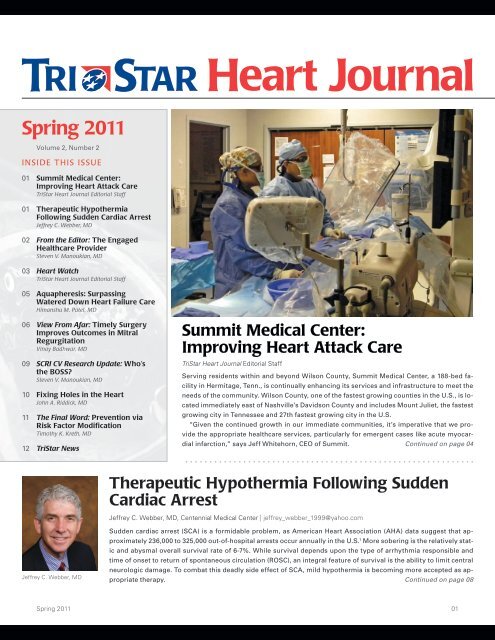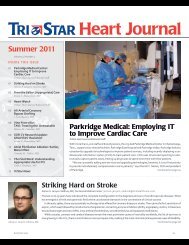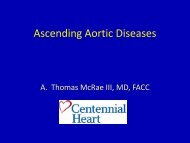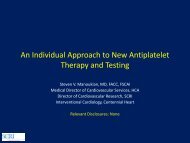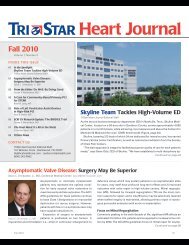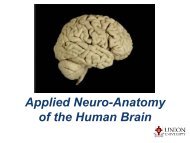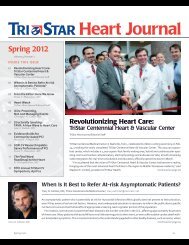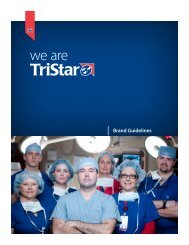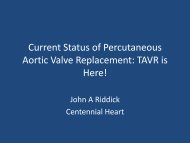Spring 2011 - TriStar Health
Spring 2011 - TriStar Health
Spring 2011 - TriStar Health
You also want an ePaper? Increase the reach of your titles
YUMPU automatically turns print PDFs into web optimized ePapers that Google loves.
<strong>Spring</strong> <strong>2011</strong><br />
Volume 2, Number 2<br />
INSIDE THIS ISSUE<br />
01 Summit Medical Center:<br />
Improving Heart Attack Care<br />
<strong>TriStar</strong> Heart Journal Editorial Staff<br />
01 Therapeutic Hypothermia<br />
Following Sudden Cardiac Arrest<br />
Jeffrey C. Webber, MD<br />
02 From the Editor: The Engaged<br />
<strong>Health</strong>care Provider<br />
Steven V. Manoukian, MD<br />
03 Heart Watch<br />
<strong>TriStar</strong> Heart Journal Editorial Staff<br />
05 Aquapheresis: Surpassing<br />
Watered Down Heart Failure Care<br />
Himanshu M. Patel, MD<br />
06 View From Afar: Timely Surgery<br />
Improves Outcomes in Mitral<br />
Regurgitation<br />
Vinay Badhwar, MD<br />
09 SCRI CV Research Update: Who’s<br />
the BOSS?<br />
Steven V. Manoukian, MD<br />
10 Fixing Holes in the Heart<br />
John A. Riddick, MD<br />
11 The Final Word: Prevention via<br />
Risk Factor Modification<br />
Timothy K. Kreth, MD<br />
12 <strong>TriStar</strong> News<br />
Summit Medical Center:<br />
Improving Heart Attack Care<br />
<strong>TriStar</strong> Heart Journal Editorial Staff<br />
Serving residents within and beyond Wilson County, Summit Medical Center, a 188-bed facility<br />
in Hermitage, Tenn., is continually enhancing its services and infrastructure to meet the<br />
needs of the community. Wilson County, one of the fastest growing counties in the U.S., is located<br />
immediately east of Nashville’s Davidson County and includes Mount Juliet, the fastest<br />
growing city in Tennessee and 27th fastest growing city in the U.S.<br />
“Given the continued growth in our immediate communities, it’s imperative that we provide<br />
the appropriate healthcare services, particularly for emergent cases like acute myocardial<br />
infarction,” says Jeff Whitehorn, CEO of Summit.<br />
Continued on page 04<br />
Therapeutic Hypothermia Following Sudden<br />
Cardiac Arrest<br />
Jeffrey C. Webber, MD, Centennial Medical Center jeffrey_webber_1999@yahoo.com<br />
Jeffrey C. Webber, MD<br />
Sudden cardiac arrest (SCA) is a formidable problem, as American Heart Association (AHA) data suggest that approximately<br />
236,000 to 325,000 out-of-hospital arrests occur annually in the U.S. 1 More sobering is the relatively static<br />
and abysmal overall survival rate of 6-7%. While survival depends upon the type of arrhythmia responsible and<br />
time of onset to return of spontaneous circulation (ROSC), an integral feature of survival is the ability to limit central<br />
neurologic damage. To combat this deadly side effect of SCA, mild hypothermia is becoming more accepted as appropriate<br />
therapy.<br />
Continued on page 08<br />
<strong>Spring</strong> <strong>2011</strong> 01
From the Editor<br />
The Engaged <strong>Health</strong>care Provider<br />
en·gaged adj. \in-’gãjd, en-\ greatly interested; committed<br />
Steven V. Manoukian, MD, Medical Director of Cardiovascular Services, Hospital Corporation of America<br />
steven.manoukian@hcahealthcare.com<br />
Editor-in-Chief<br />
Steven V. Manoukian, MD,<br />
Hospital Corporation of<br />
America<br />
EDITORIAL BOARD<br />
Cardiac Imaging<br />
David C. Huneycutt, Jr., MD<br />
Centennial Medical Center<br />
Nashville, Tenn.<br />
david.huneycutt@<br />
hcahealthcare.com<br />
Cardiothoracic Surgery<br />
Davis C. Drinkwater, Jr., MD<br />
Centennial Medical Center<br />
Nashville, Tenn.<br />
davis@ddrinkwater.com<br />
Electrophysiology<br />
Gregory G. Bashian, MD<br />
Centennial Medical Center<br />
Nashville, Tenn.<br />
gregory.bashian@<br />
hcahealthcare.com<br />
General Cardiology<br />
David E. Chambers, MD<br />
Horizon Medical Center<br />
Dickson, Tenn.<br />
dchambers@dicksonmd.com<br />
CONTACT US<br />
<strong>TriStar</strong> Heart Journal<br />
Editorial Staff<br />
110 Winners Circle<br />
Brentwood, TN 37027<br />
thj@hcahealthcare.com<br />
cardiac.tristarhealth.com<br />
(800) 242-5662<br />
The Free Merriam-Webster Dictionary defines engaged as “greatly interested” or “committed.”<br />
Traditionally, healthcare providers have shown engagement by providing high-quality direct patient<br />
care, in order to prolong and improve the quality of their patients’ lives.<br />
In today’s healthcare, being an engaged provider extends beyond direct patient care. Providers<br />
and their facilities are not only becoming more engaged with one another, but also more<br />
aligned and accountable to further enhance the quality, cost-effectiveness and efficiency of<br />
care. Eventually, new healthcare delivery systems, defined by the Centers for Medicare & Medicaid<br />
Services as accountable care organizations (ACOs), may shape the new manner in which<br />
healthcare is delivered. ACOs will link provider reimbursements to metrics assessing both quality<br />
and cost. By definition, ACOs will need to be accountable for the care they provide to succeed<br />
in the era of healthcare reform. Consequently, providers, healthcare administrators, third-party<br />
payers, governmental bodies, industry and essentially all facets of U.S. healthcare will need to<br />
become more engaged and aligned.<br />
For providers, being engaged will require effort and possibly a change in mindset, since gaining<br />
an understanding of future healthcare barriers, championing quality improvement programs, as<br />
well as reducing unnecessary costs and clinical variation are new, challenging concepts.<br />
However, providing top-notch direct patient care will always be important for caregivers and<br />
administrators and will continue to require an extensive, up-to-date fund of knowledge. To this<br />
end, <strong>TriStar</strong> Heart Journal (THJ) strives to be a valuable engagement tool, providing information<br />
about new provider and facility strategies to enhance accountable care. Your engagement with<br />
THJ has enabled the journal to grow to 12 pages, allowing for expanded content and new features.<br />
Among the new features, Heart Watch will concisely highlight results from major scientific<br />
meetings and recent journal publications. View From Afar will feature a national or international<br />
expert from beyond <strong>TriStar</strong>. In this issue, Vinay Badhwar, a renowned cardiothoracic surgeon<br />
from Osceola Regional Medical Center in Kissimmee, Fla., shares his expertise regarding the<br />
timing and techniques to optimize surgical outcomes in mitral valvular disease.<br />
Also in this issue is expert information from Jeffrey Webber from Centennial on therapeutic<br />
hypothermia, who underscores that the neurologic impact of sudden cardiac arrest often rivals<br />
or exceeds the cardiovascular manifestations. Next, Summit Medical Center describes its new,<br />
comprehensive, 24/7 primary PCI program for patients with ST-elevation myocardial infarction,<br />
in addition to its expansion of the emergency department. Aquapheresis, a valuable tool to improve<br />
outcomes, decrease complications and perhaps reduce costs and prevent readmissions<br />
in acute heart failure, is presented by Himanshu Patel, and includes his personal experience with<br />
this new technology at Redmond Regional. Centennial’s experienced structural heart disease interventionalist,<br />
John Riddick gives a primer on when percutaneous ASD/PFO repair should be<br />
considered. In The Final Word, Summit’s Timothy Kreth shares his approach to the important<br />
topic of risk factor modification, especially in the primary prevention setting. Lastly, in the SCRI<br />
CV Research Update, the BOSS Trial, which is exploring the use of sodium bicarbonate to reduce<br />
contrast-induced nephropathy, is reviewed, as well as other important trials being performed in<br />
SCRI’s growing six-site cardiovascular strategic network.<br />
THJ appreciates your readership and is committed to enhancing your ability to engage in accountable,<br />
high-quality care. <br />
For author inquiries, contact steven.manoukian@hcahealthcare.com<br />
02 <strong>TriStar</strong> Heart Journal
Heart Watch<br />
Atrial fibrillation mapping tool shows benefit<br />
The use of a diagnostic mapping tool helped terminate or<br />
slow atrial fibrillation (AF) with less than 10 minutes of ablation,<br />
according to the late-breaking CONFIRM trial presented<br />
May 5 at the 32nd annual Heart Rhythm Society (HRS) scientific<br />
sessions. Researchers found that focal impulse and rotor<br />
modulation (FIRM) ablation increased two-year freedom<br />
of AF by 70%.<br />
The study enrolled 103 patients; 67% of whom had persistent<br />
AF and 33% had paroxysmal AF. The researchers split patients<br />
into two groups to receive either FIRM-guided ablation<br />
for less than 10 minutes per rotor focus followed by a wide-area<br />
circumferential ablation (WACA) for pulmonary vein isolation<br />
(32 patients) or WACA alone (71 patients).<br />
According to the authors, acute AF termination or slowing<br />
occurred in 88% of patients in the FIRM-guided arm compared<br />
with 14% in the conventional arm. Additionally, the two-year<br />
data showed that 84.3% of patients in the FIRM-guided arm<br />
were free of AF compared with 50.5% in the conventional arm.<br />
In the majority of patient cases sinus rhythm was achieved<br />
in 10 to 15 minutes. The researchers also reported that FIRMalone<br />
terminated AF to sinus rhythm in six minutes (17 patients)<br />
and lengthened AF cycle length by more than 15%. Single<br />
procedure freedom from AF at one year was 25% higher<br />
for FIRM-WACA compared with WACA alone.<br />
Subcutaneous ICDs prove effective<br />
A subcutaneous implantable cardioverter-defibrillator (S-ICD)<br />
system was 100% effective in converting and detecting induced<br />
ventricular fibrillation (VF) through shock, according to<br />
a study presented May 4 at HRS. Therefore, the researchers<br />
concluded that the S-ICD system can therefore be comparable<br />
to conventional ICD therapy.<br />
Ninety-eight patients were implanted with S-ICDs in three<br />
sites in the Netherlands. The devices were implanted according<br />
to international guidelines and were tested using 65<br />
shocks. After a nine-month follow-up, the researchers reported<br />
that there were no hospitalizations due to heart failure and<br />
no patients experienced episodes of sudden cardiac death.<br />
Additionally, the systems acutely detected and converted episodes<br />
of induced VF 100% of the time.<br />
The researchers also reported that 34 sustained or non-sustained<br />
spontaneous ventricular arrhythmias were detected in six<br />
patients and 23 arrhythmic episodes were treated in three patients.<br />
RIVAL confounds the transradial PCI debate<br />
Radial access for percutaneous coronary intervention (PCI) in<br />
patients with acute coronary syndromes (ACS) does not reduce<br />
a combined endpoint of death, heart attack, stroke or major<br />
bleeding compared with femoral access, according to the<br />
late-breaking RIVAL trial presented April 4 at the 60th annual<br />
American College of Cardiology (ACC) scientific sessions.<br />
Access Site Major Bleeds<br />
6* Allocated to Radial HR 0.50 (95% CI 0.19-1.33)<br />
12<br />
Between June 2006 and November 2010, RIVAL enrolled<br />
7,021 patients from 158 hospitals in 32 countries and randomly<br />
assigned them to radial (3,507 patients) or femoral access<br />
(3,514). The primary outcome was death, MI, stroke or non-<br />
CABG-related major bleeding at 30 days, which occurred in<br />
3.7% in the radial access group compared with 4% in the femoral<br />
access group. The rate of death, MI or stroke at 30 days<br />
was 3.2% in the radial group compared with 3.2% in the femoral<br />
group.<br />
Allocated to Femoral<br />
*All access site major bleeds actually occurred at femoral<br />
arterial site (in radial group due to cross-over or IABP).<br />
Source: RIVAL investigators, ACC11 Presentation.<br />
Radial arteries best saphenous vein grafts for<br />
CABG at 5 years<br />
For coronary artery bypass graft (CABG) surgery, radial arteries<br />
are associated with reduced rates of functional and complete<br />
graft occlusion, as well as less graft disease, than saphenous<br />
veins, according to the five-year results of the RAPS<br />
late-breaking clinical trial, presented April 4 at ACC.<br />
The study enrolled 561 patients who underwent CABG for<br />
three-vessel disease. Each patient received both a radial artery<br />
graft and a saphenous vein graft at two different diseased<br />
vessel sites. The primary endpoint of functional graft occlusion<br />
was determined through invasive angiography at least<br />
five years after surgery. The secondary endpoint was complete<br />
graft occlusion determined through invasive angiography<br />
or computed tomography angiography.<br />
The researchers conducted late angiography on 440 patients<br />
alive at one year and on 269 patients at a mean of 7.6<br />
years post-procedure. In the latter follow-up, they found that<br />
significantly fewer radial arteries became partially occluded<br />
than saphenous vein grafts, at 12% and 18.8%, respectively.<br />
Significantly fewer radial arteries also became completely<br />
occluded, at 8.9%, than saphenous veins, at 17.8%. <br />
<strong>Spring</strong> <strong>2011</strong> 03
Summit Medical Center: Improving Heart Attack Care<br />
Continued from page 01<br />
“Because Tennessee has very high, statewide rates of heart<br />
disease, fueled by a tradition of unhealthy lifestyle habits,<br />
proper services are needed to serve this population,” Whitehorn<br />
adds.<br />
In fact, more than one out of four deaths in Tennessee is<br />
due to heart disease, according to the 2009 Centers for Disease<br />
Control and Prevention report. And heart disease is the<br />
leading cause of death for both women and men in the state.<br />
To address these needs, Summit has renewed offering primary<br />
percutaneous coronary intervention (PCI) services for<br />
patients with ST-elevation myocardial infarction (STEMI), 24<br />
hours a day, seven days a week (24/7). In order to provide<br />
these services on a continuous basis, Summit hired two new<br />
interventional cardiologists, for a total of four, allowing the<br />
provider to begin offering 24/7 STEMI care in January <strong>2011</strong>.<br />
While the hospital performed six PCI procedures in January,<br />
the PCI volume more than doubled in February to 14 procedures.<br />
“When we previously offered 24/7 STEMI care, Summit<br />
averaged 24 PCI procedures per month. In addition, in 2006,<br />
we performed between 60 to 90 diagnostic catheterizations<br />
monthly,” explains Holly Hill, RN, MSN, director of cardiac<br />
services at Summit. “We hope to achieve those levels of volume<br />
again with the renewal of this program.”<br />
“We are excited to offer 24/7 PCI at Summit Medical Center,”<br />
says Randy Farrar, RN, BSN, CEN, director of emergency and critical<br />
care services at Summit. “Time is muscle; every minute saved<br />
improves the chances of a better outcome for our patients.”<br />
The American College of Cardiology recommends a doorto-balloon<br />
time for primary PCI for STEMI of less than 90<br />
minutes. The average door-to-balloon time at Summit is 64<br />
minutes for STEMI and patients who require surgery are<br />
transferred to Centennial Medical Center, which is 15 miles<br />
away. During the fourth quarter of 2010, Summit’s door-toballoon<br />
time averaged 56 minutes.<br />
In an effort to shave off a few more minutes of their doorto-balloon<br />
times, Summit evaluates each case to identify opportunities<br />
for improvement. Methods put in place include:<br />
activation of cath lab from the field via EMS, immediate triage<br />
of chest pain patients and cross-training<br />
of emergency department staff in the catheterization<br />
lab.<br />
Communication between the various provider<br />
services and having the technologies to<br />
make information accessible to the appropriate<br />
caregivers is “extremely important, as this<br />
will only serve to improve patient outcomes,”<br />
Whitehorn says.<br />
The emergency department has served approximately<br />
48,000 patients over the past two<br />
years. Summit is currently undergoing a $7<br />
million expansion that will increase the number<br />
of beds in the emergency department to<br />
32, compared with its current number of 23<br />
beds. The expansion is expected to be completed<br />
by Aug. 1.<br />
“One of the reasons for the renovation is to<br />
meet the demands of the growing population,” says Farrar.<br />
“This expansion has been implemented to better serve the<br />
needs of our community. It will not only add rooms but will reduce<br />
wait times as well.”<br />
Within the emergency department expansion, Summit also<br />
has dedicated a certain number of beds to an emergency department<br />
fast track, which “allows us to see and treat those<br />
patients who are more acutely ill in a faster, more efficient<br />
manner,” Whitehorn explains. “These dedicated rooms will<br />
improve the patient experience for all those who enter the<br />
emergency department, as the workflow will be streamlined<br />
based on the needs of the patient on arrival.”<br />
Farrar believes this fast track process will result in an increase<br />
in patient satisfaction, as this will lead to a decrease<br />
in emergency department wait times for emergent and nonemergent<br />
cases.<br />
“Currently in healthcare, quality is measured and publicly<br />
reported more frequently than ever, making our patients more<br />
informed consumers,” Whitehorn says. “While that type of<br />
transparency may be a hard adjustment for providers, it is our<br />
responsibility to produce excellent patient outcomes across<br />
the various specialties, including cardiology services.” <br />
04 <strong>TriStar</strong> Heart Journal
Aquapheresis:<br />
Surpassing Watered Down Heart Failure Care<br />
Himanshu M. Patel, MD, Redmond Regional Medical Center hpatel@harbinclinic.com<br />
Due to the prolongation of life resulting<br />
from the advances in cardiovascular<br />
therapeutic innovations<br />
and the aging population, the prevalence<br />
of congestive heart failure<br />
(CHF) is increasing. Treatment strategies<br />
for CHF vary widely, resulting<br />
in mortality which remains exceedingly<br />
high. The American Heart Association<br />
estimated there were 5.8<br />
Himanshu M. Patel, MD million people with CHF in the U.S.<br />
in 2006. Furthermore, average survival<br />
after a patient’s first hospitalization for CHF is alarmingly<br />
low: 1.7 years for women and 2.3 years for men. Heart failure is<br />
also one of the most common causes of hospitalization and readmission.<br />
In 2006, the U.S. heart failure hospitalization rate was<br />
23 per 1,000 for men over the age of 64 and 20 per 1,000 for women<br />
over the age of 64, making it the leading cause of hospitalization<br />
in this age group 1 . Lastly, about a quarter of those who are<br />
hospitalized with heart failure are readmitted within 30 days 2 .<br />
Despite the severity, inpatient CHF treatment has remained<br />
relatively unchanged. Cornerstones of treatment include intravenous<br />
diuretics, sodium and fluid restriction, ACE inhibitors<br />
or ARBs, beta-blockers, BP control and aldosterone blockers.<br />
Other useful tools include inotropic agents in low cardiac<br />
output states and nesiritide infusions in hypertensive states.<br />
A common complication of intravenous diuretic treatment<br />
is a fall in cardiac output induced by loop diuretic therapy,<br />
which has important implications for the time course of diuresis.<br />
In both stable individuals and those with CHF, ensuing<br />
activation of sodium-retaining mechanisms (angiotensin II,<br />
aldosterone and norepinephrine), as well as flow-dependent<br />
hypertrophy in the renal distal tubule limits the response to<br />
continued diuretic therapy and can lead to prolonged hospitalization<br />
and readmission for CHF.<br />
This complication of diuretics and others limit their efficacy,<br />
resulting in a need for new methods to remove fluid safely and<br />
efficiently. In addition, there is a need to provide inpatient treatments<br />
that have the potential to reduce re-hospitalization.<br />
At Redmond Regional Medical Center in Rome, Ga., we<br />
have initiated an alternative FDA-approved treatment to remove<br />
fluid, called aquapheresis. We have been using this<br />
method for more than 19 months with great success.<br />
Also known as ultrafiltration, the technique involves the removal<br />
of blood through a peripheral or central venous catheter. Salt<br />
and water is filtered from the blood through a console containing<br />
two pumps. Excess fluid and salt are removed and collected in a<br />
bag and blood is returned to the body in less than a minute. Patients<br />
are anticoagulated prior to and during treatment to prevent<br />
clotting within the blood filter. Approximately 33 cc of extracorporeal<br />
blood is extracted at any given time. An average of 100 cc to<br />
500 cc of fluid can be removed per hour, which can be adjusted.<br />
Electrolyte balance is easier to maintain than traditional diuresis.<br />
Treatment duration depends on the patient’s condition, but average<br />
procedure duration is 24-72 hours in the inpatient setting.<br />
Redmond Regional Medical Center<br />
Heart Failure Data<br />
Readmission Rate (within 30 days)<br />
Standard Heart Failure (HF) Treatment 20%<br />
Aquapheresis 12%<br />
Length of Hospital Stay<br />
Standard HF Treatment<br />
Aquapheresis<br />
Aquapheresis within 24 hrs<br />
The UNLOAD trial was the first study to demonstrate the<br />
safety and efficacy of aquapheresis 3 . Emergency room patients<br />
with acute, decompensated CHF were randomized to<br />
standard treatment versus aquapheresis. At 90 days, patients<br />
treated with aquapheresis had a 50% reduction in rehospitalization,<br />
63% reduction in hospitalized days and a 52% reduction<br />
in emergency room visits/clinic visits. The study concluded<br />
that in decompensated CHF, ultrafiltration via aquapheresis<br />
safely produces greater weight and fluid loss than intravenous<br />
diuretics, reduces 90-day resource utilization for heart<br />
failure and is an effective alternative therapy.<br />
Utilizing this technique, Redmond has halved its 30-day readmission<br />
rates at the hospital, compared with standard treatment<br />
patients. Also, the length of hospital stay is almost 1-2 days less<br />
compared with conventionally treated CHF patients. <br />
REFERENCES:<br />
6.2 Days<br />
5.2 Days<br />
3.9 Days<br />
Source: Unpublished<br />
1. Liu L. Changes in Cardiovascular Hospitalization and Co-morbidity of HF in the U.S.:<br />
Findings from the National Hospital Discharge Surveys 1980-2006. Int J Cardiol<br />
<strong>2011</strong>;149(1):39-45.<br />
2. Jencks SF, Williams MV, and Coleman EA. Rehospitalizations among patients in the<br />
Medicare fee-for-service program. N Engl J Med 2009;360(14):1418-1428.<br />
3. Costanzo MR, Guglin ME, Saltzberg MT, et al. Ultrafiltration Versus Intravenous<br />
Diuretics for Patients Hospitalized for Acute Decompensated HF. J Am Coll Cardiol<br />
2007;49:675-683.<br />
<strong>Spring</strong> <strong>2011</strong> 05
View from Afar<br />
Timely Surgery<br />
Improves Outcomes in Mitral Regurgitation<br />
Vinay Badhwar, MD, Osceola Regional Medical Center, Kissimmee, Fla. vbadhwar@heartsurgery-csa.com<br />
Vinay Badhwar, MD<br />
Many patients with heart failure<br />
also have structural heart disease,<br />
which can be coronary or valvular—the<br />
latter of which is commonly<br />
mitral-based. Mitral regurgitation<br />
(MR) is increasingly prevalent in the<br />
aging population, and may lead to<br />
substantial all-cause morbidity and<br />
mortality, particularly in those with<br />
heart failure. Timely surgical referral<br />
of these patients is truly important<br />
for improved clinical outcomes.<br />
The problem of MR can be divided into two broad etiologies:<br />
primary leaflet-based pathology or ventricular-based pathology.<br />
Leaflet pathologies consist of myxomatous degeneration<br />
(or mitral valve prolapse with a problem of excess<br />
This is the first installment in<br />
our “View from Afar” series, in<br />
which we will be inviting expert<br />
physicians from beyond the<br />
<strong>TriStar</strong> <strong>Health</strong> System to write on<br />
a variety of cardiovascular topics.<br />
leaflet), or fibroelastic deficiency<br />
(or thin leaflets with flailed isolated<br />
segment), the latter of which<br />
is more common in the elderly.<br />
Ventricular pathologies of dilated<br />
or ischemic heart failure result<br />
in functional MR caused by leaflet<br />
tethering associated with ventricular dilation. Particularly for<br />
this second subset, it is integral to intervene before the disease<br />
has progressed too far, because even if the valve is fixed,<br />
the ventricle still has the potential to fail.<br />
When to intervene?<br />
In triaging when a patient should be referred for an intervention<br />
of the mitral valve, the recently updated ACC/AHA guidelines<br />
point to specific symptoms related to dyspnea, such as<br />
recurring congestive heart failure, NYHA Class of ≥3 or orthopnea<br />
1 . Also, if a patient is asymptomatic, and develops atrial fibrillation,<br />
it may be a marker of late progression of MR. Often,<br />
these patients can be treated with concomitant atrial fibrillation<br />
procedures at the time of mitral valve repair. There is increasing<br />
evidence, based upon echocardiographic studies, that pulmonary<br />
hypertension may also be a marker of late progression<br />
of MR 2 . These patients should be referred for surgery earlier.<br />
For those who are symptomatic and have severe MR, the<br />
patient should be referred immediately. In fact, the natural<br />
history of severe MR notes a seven-year survival benefit in<br />
patients who are asymptomatic, and a five-year survival benefit<br />
for those who are symptomatic. This is not a benign disease.<br />
Patients with severe symptomatic MR, who are treated<br />
with medical therapy fair quite poorly, not only in terms of<br />
quality of life due to recurrent heart failure but also due to limited<br />
short-term survival.<br />
When to refer?<br />
However, it is less clear for physicians when to refer asymptomatic<br />
patients for intervention, which is why retrospective<br />
and prospective studies have helped to inform the field. In<br />
a recent longitudinal study, early surgical intervention was<br />
compared with watchful waiting for 447 asymptomatic severe<br />
MR patients. Estimated actuarial seven-year cardiac mortality<br />
was 0% in the operated group and 5% in the conventional<br />
treatment group, and for 127 propensity score-matched pairs,<br />
the estimated actuarial seven-year event-free survival rate<br />
was significantly higher in the operated than in the conventional<br />
treatment group 3 .<br />
Many global studies have consistently shown that early<br />
intervention in severe valvular pathology not only improves<br />
long-term quality of life, but also confers a significant survival<br />
advantage. Patients who undergo mitral valve repair can resume<br />
a normal life and anticipate a normal life expectancy.<br />
Also, new longitudinal data indicate that if the valve is repaired<br />
in a timely manner, the patient can achieve normalization<br />
of ventricular function 4 . Of 1,063 patients who underwent<br />
mitral valve surgery over a 20-year period, 87% of patients underwent<br />
valve repair and 13% underwent replacement. Factors<br />
including higher preoperative ejection fraction, smaller<br />
left ventricular dimensions and performance of valve repair<br />
(versus replacement) were associated with a higher ejection<br />
fraction at follow-up. The researchers concluded that early repair<br />
of MR caused by leaflet prolapse, before deterioration in<br />
left heart size or function, increases the likelihood of subsequent<br />
normalization of left ventricular ejection fraction.<br />
In addition to symptomatic criteria, the guidelines also recommend<br />
that patients should be assessed based upon anatomic<br />
criteria, such as left ventricular end-diastolic dimension<br />
or volume and referred before the heart dilates 1 . Left ventricular<br />
end-diastolic dimension of 40 mm is the new bar which<br />
confers advantage of mitral valve repair.<br />
All of these symptomatic and anatomic factors can assist<br />
physicians with knowing how to interpret MR and when to refer<br />
patients for mitral valve surgery.<br />
In summary, if a patient is even mildly symptomatic and the<br />
patient has severe MR due to a flail mitral leaflet, he or she<br />
06 <strong>TriStar</strong> Heart Journal
Normal<br />
Infarct<br />
(Left) Balance of forces acting on mitral leaflets in systole. (Right) Effect of papillary muscle displacement. Dark shading indicates<br />
inferobasal myocardial infarction; and light shading indicates normal baseline.<br />
Source: Di Salvo, T.G, Acker, MA, Dec, GW et al. Mitral Valve Surgery in Advanced Heart Failure. J Am Coll Cardiol 2010;55:271-282.<br />
should be referred for surgical repair. If a patient is asymptomatic<br />
with severe MR, then he or she should be followed until<br />
their left ventricular end-diastolic dimension is greater than<br />
40 mm or they develop pulmonary hypertension or any other<br />
structural sign of deterioration of the heart such as atrial fibrillation<br />
or right or left atrial enlargement.<br />
However, if the patient is symptomatic, but the MR is not<br />
severe on transthoracic echocardiography, further studies are<br />
recommended such as transesophageal or stress echocardiography.<br />
In these cases, quantification methods on echocardiography<br />
are beneficial in examining the effective regurgitant<br />
orifice of the mitral valve to assess the severity of the MR.<br />
Early repair of MR can result in recovery of ventricular function<br />
and restoration of normal life expectancy. <br />
Dr. Badhwar is a renowned cardiothoracic surgeon, with<br />
specialized training and expertise in surgical valvular repair<br />
techniques. He is widely published in the medical literature,<br />
active in research and lectures. Dr. Badhwar received his medical<br />
degree in 1993 from the University of Ottawa, performed<br />
his residency at McGill University and the University of Ottawa<br />
Heart Institute and fellowship at the University of Michigan.<br />
REFERENCES:<br />
1. Bonow RO, Carabello BA, Chatterjee K, et al. 2008 ACC/AHA 2006 guidelines for<br />
the management of patients with valvular heart disease: a report of the American<br />
College of Cardiology (ACC)/American Heart Association (AHA) Task Force on Practice<br />
Guidelines. J Am Coll Cardiol 2006;48:e1-e148.<br />
2. Barbieri A, Bursi F, Grigioni F, et al. Prognostic and therapeutic implications of<br />
pulmonary hypertension complicating degenerative mitral regurgitation due to flail<br />
leaflet. Eur Heart J <strong>2011</strong>;32:751-759.<br />
3. Kang DH, Kim JH, Rim JH, et al. Comparison of early surgery versus conventional<br />
treatment in asymptomatic severe mitral regurgitation Circulation 2009;119:797-804.<br />
4. Suri RM, Schaff HV, Dearani JA, et al. Recovery of left ventricular function after<br />
surgical correction of MR caused by leaflet prolapsed. J Thorac Cardiovasc Surg<br />
2009;137:1071-1076.<br />
<strong>Spring</strong> <strong>2011</strong> 07
Therapeutic Hypothermia Following Sudden Cardiac Arrest<br />
Continued from page 01<br />
Research seeking to prevent neurologic injury from SCA<br />
dates back nearly 50 years, but initiatives to pursue this therapy<br />
were initially derailed by concern over potential therapeutic<br />
side effects and lack of efficient, timely ways to achieve desired<br />
core temperature. Two landmark randomized controlled<br />
trials triggered a renewed interest in hypothermia that is now<br />
being incorporated in hospitals across the U.S.<br />
The data from these studies are compelling. First, the Australian<br />
study of 77 comatose patients following ventricular fibrillation<br />
(VF) arrest 2 assessed moderate cooling (33 °C, achieved<br />
with ice packs and intermittent sedation/paralysis for 12 hours)<br />
Mild Therapeutic Hypothermia to Improve the<br />
Neurologic Outcome After Cardiac Arrest<br />
and found that “good” clinical outcomes (discharge to home or<br />
rehabilitation unit) were significantly better with hypothermia<br />
vs. control (49% vs. 26%), as were death rates (51% vs. 68%).<br />
In the second study, 275 patients with VF or ventricular<br />
tachycardia (VT) arrest and ROSC within 60 minutes were randomized<br />
to mild hypothermia (89.6-93.2 °F utilizing cold air<br />
mattress, ice packs and sedation/paralysis as needed for 24<br />
hours) vs. standard ICU care 3 and followed up to six months.<br />
A favorable neurologic outcome was achieved in 55% of the<br />
hypothermia-treated patients vs. 39% of control patients, with<br />
mortality rates of 41% vs. 55%, respectively.<br />
These promising results propelled a discussion regarding<br />
appropriate policies for mild hypothermia therapy that culminated<br />
in recommendations from the European Resuscitation<br />
Council and the AHA in 2005. These statements recommend<br />
mild hypothermia as one of many compelling treatments for<br />
post-arrest patients presenting with VT or VF as their initial<br />
arrhythmia.<br />
Favorable<br />
Neurologic<br />
55%<br />
Outcome<br />
P=0.009 39%<br />
Death<br />
P=0.02<br />
41%<br />
55%<br />
■ Hypothermia ■ Normothermia<br />
Source: The Hypothermia after Cardiac Arrest<br />
Study Group. N Engl J Med 2002;346:549-556.<br />
Practical Considerations<br />
Various methods of cooling are available. Most readily available<br />
options for inducing hypothermia include ice packs about<br />
the torso and head, infusion of chilled (4 °C) intravenous normal<br />
saline or Lactated Ringers and utilization of cooling blankets.<br />
More sophisticated therapies include intranasal evaporative<br />
cooling techniques, localized external head cooling<br />
apparatuses, specially built cooling beds, and even intravascular<br />
catheter-based cooling technology.<br />
Serious side effects of hypothermia therapy include refractory<br />
ventricular arrhythmias, electrolyte imbalances, infection<br />
and coagulopathies and are more frequent in patients<br />
with cooling “overshoot” (which may occur in 13% of patients).<br />
However, it is unclear that differences in complication<br />
rates between hypothermia-treated and control<br />
groups meaningfully alter outcomes 3 .<br />
The efficacy of hypothermia in SCA patients<br />
presenting with arrhythmias other than VT or VF<br />
remains unclear, as data from limited retrospective<br />
trials suggest a benefit of lesser magnitude.<br />
As is frequently the case, converting trial-generated<br />
data into practical day-to-day beneficial<br />
results is proving to be a monumental task. Many<br />
questions remain regarding further risk stratification,<br />
optimal time of cooling and optimal methods<br />
of achieving target temperatures.<br />
Still, healthcare professionals are increasingly<br />
embracing the concept of mild hypothermia in<br />
post-arrest patients. Indeed, there is momentum<br />
afoot to regionalize such care in an effort to decrease<br />
inter-hospital variability in outcomes across the U.S.<br />
City-wide efforts in this area are fully underway in New York, for<br />
example. There, news attention recently focused on EMS personnel<br />
now administering chilled IV fluids prepared in special<br />
refrigerator-equipped ambulances to accelerate the process of<br />
cooling in the field. In addition, the funneling of resources that<br />
would lead to directing victims of SCA to regional centers was<br />
proposed in a recent AHA policy statement 1 .<br />
Implementation of therapeutic hypothermia is fast becoming<br />
the standard of care. Policies and methodologies aimed<br />
at decreasing time to cooling will be increasingly refined. As<br />
doctors, nurses and EMS personnel become more comfortable<br />
with and facile at delivering this therapy, we will also begin<br />
to understand its limitations, as well as potentially be able<br />
to extrapolate its benefits to patients in other scenarios. <br />
REFERENCES:<br />
1. Nichol, G, Aufderheide, TP, Eigel, B, et al. Regional Systems of Care for<br />
Out-of-Hospital Cardiac Arrest: A Policy Statement from the AHA. Circulation<br />
2010;121:709-729.<br />
2. The Hypothermia after Cardiac Arrest Study Group. Mild therapeutic hypothermia<br />
to improve the neurologic outcome after cardiac arrest. N Engl J Med<br />
2002;346:549-556.<br />
3. Bernard SA, Gray TW, Buist MD, et al. Treatment of comatose survivors of out-ofhospital<br />
cardiac arrest with induced hypothermia. N Engl J Med 2002;346:557-563.<br />
08 <strong>TriStar</strong> Heart Journal
SCRI CV Research Update<br />
Who’s the BOSS?<br />
Steven V. Manoukian, MD, Director of Cardiovascular Research, Sarah Cannon Research Institute (SCRI)<br />
steven.manoukian@scresearch.net<br />
“BOSS, a national, randomized trial, is powered to determine whether high-dose<br />
Chronic kidney disease (CKD) affects 20% bicarbonate can prevent long-term loss of renal function (death, renal replacement<br />
of patients with cardiovascular disease therapy or significant decrease in GFR persisting at six months) by preventing the<br />
and nearly triples rates of short-term impact of arterial contrast on high-risk patients.”<br />
mortality and adverse ischemic events Harold L. Dauerman, MD, U.S. Co-Principal Investigator for BOSS trial and Director of Cardiac<br />
in acute coronary syndromes (ACS) and Catheterization Laboratories at the University of Vermont<br />
percutaneous coronary intervention<br />
(PCI). In addition to advancing age, anemia<br />
and use of a standard regimen of a<br />
glycoprotein IIb/IIIa inhibitor, CKD is a<br />
powerful risk factor for bleeding 1-2 .<br />
Beyond its adverse effects on ischemic<br />
and bleeding events, CKD increases<br />
the risk of contrast-induced nephropathy<br />
(CIN), a form of acute renal failure in<br />
patients undergoing cardiac catheterization<br />
or PCI using iodinated contrast media.<br />
CIN is associated with an increase<br />
in adverse outcomes, including mortality,<br />
need for dialysis, other adverse outcomes<br />
and prolongation (and increased<br />
cost) of hospital stay. Rates of CIN vary<br />
widely depending upon baseline renal<br />
Current SCRI Cardiovascular Research<br />
TRIAL<br />
ABILITY<br />
AMGEN - HF<br />
BOSS<br />
BRADYCARE<br />
HCRI-DAPT<br />
HESTIA<br />
ION<br />
IRASE<br />
LONGEVITY<br />
PHOENIX<br />
PREVAIL<br />
PROMISE<br />
QUICKFLEX<br />
ROCHE - ACS<br />
ROCHE - SURGERY<br />
SAPPHIRE<br />
STARFIX<br />
THRIVE<br />
USPELLA<br />
Description<br />
EP device lead follow-up<br />
function (usually estimated by the glomerular<br />
filtration rate, or eGFR) and how<br />
CIN is defined 3 . The lack of consistent efficacy<br />
has hindered consensus regarding<br />
best practices for CIN prevention.<br />
One promising CIN preventive strategy<br />
being assessed in three of SCRI’s<br />
cardiovascular strategic sites is intravenous<br />
(IV) sodium bicarbonate (NaH-<br />
CO 3<br />
). The BOSS Trial (Evaluation of<br />
Sodium Bicarbonate to Reduce Contrast-Induced<br />
Chronic Kidney Injury<br />
in Subjects with Advanced CKD who<br />
are Undergoing Angiography) is comparing<br />
IV NaHCO 3<br />
to sodium chloride<br />
(NaCl) prior to, during and after arterial<br />
angiographic procedures, such as cardiac<br />
catheterization and PCI, in patients<br />
with advanced CKD (defined as eGFR of<br />
Omecamtiv mecarbil in acute heart failure<br />
NaHCO 3<br />
to prevent CIN w/ any arterial contrast + eGFR ≤44<br />
Pacemaker programming enhancement<br />
Dual antiplatelet therapy with any BMS or DES<br />
Dronedarone with pacemaker and atrial fibrillation<br />
Paclitaxel-eluting DES<br />
Atrial fibrillation ablation<br />
EP device follow-up<br />
Cangrelor antiplatelet therapy with any DES<br />
WATCHMAN LA closure device in atrial fibrillation<br />
Chest pain imaging study<br />
EP device lead<br />
RO4905417 in stable CAD following recent ACS<br />
Human monoclonal P-selectin antibody with CABG<br />
Carotid stenting<br />
EP device lead follow-up<br />
Aortic aneurysm repair<br />
IMPELLA 2.5 cardiac support system<br />
≤44 mL/min/1.73m 2 ).<br />
Centennial Medical Center in Nashville,<br />
Tenn., Redmond Regional Medical<br />
Center in Rome, Ga., and Northside<br />
Hospital in St. Petersburg, Fla., are three<br />
of only a handful of sites participating in<br />
this multicenter, randomized U.S. trial.<br />
The BOSS Trial will determine if the use<br />
of IV NaHCO 3<br />
in patients with advanced<br />
CKD will reduce the risk of CIN and related<br />
complications. Furthermore, if the<br />
results of BOSS are favorable, NaHCO 3<br />
may form the standard-of-care for all patients<br />
undergoing procedures utilizing<br />
iodinated contrast media.<br />
The SCRI network also includes:<br />
Osceola Regional Medical Center in<br />
Kissimmee, Fla., CJW Medical Center<br />
in Richmond, Va., and Henrico Doctors’<br />
Hospital in Richmond, Va.<br />
SCRI’s cardiovascular vision is to be<br />
a leader in cardiovascular research to<br />
provide the foundation for evidencebased<br />
strategies that facilitate optimal<br />
and cost-effective patient care. <br />
For more information on SCRI’s<br />
cardiovascular research trials, visit:<br />
www.sarahcannonresearch.com/<br />
our-research/cardiovascular. To refer<br />
a patient or be added to our email list,<br />
contact us directly at (615) 329-7274<br />
or cvresearch@scresearch.net.<br />
REFERENCES<br />
1. Mehran R, Nikolsky E, Lansky AJ, et al. Impact of<br />
chronic kidney disease on early and late outcomes<br />
of patients with ACS treated with alternative<br />
antithrombotic treatment strategies: an ACUITY<br />
substudy. JACC Cardiovasc Interv 2009;2:748-757.<br />
2. Manoukian SV, Feit F, Mehran R, et al. Impact of<br />
major bleeding on 30-day mortality and clinical<br />
outcomes in patients with ACS: an analysis from the<br />
ACUITY Trial. J Am Coll Cardiol 2007;49:1362-1368.<br />
3. Jabara R, Gadesam RR, Pendyala LK, et al.<br />
Impact of the definition utilized on the rate of<br />
contrast-induced nephropathy in PCI. Am J Cardiol<br />
2009;103:1657-1662.<br />
<strong>Spring</strong> <strong>2011</strong> 09
Fixing Holes in the Heart<br />
John A. Riddick, MD, Centennial Medical Center john.riddick@hcahealthcare.com<br />
A novel percutaneous technique<br />
for repairing an atrial septal defect<br />
(ASD) or patent foramen ovale<br />
(PFO) presents an alternative to<br />
surgery for many patients. ASD,<br />
a congenital defect that occurs in<br />
approximately four of every 10,000<br />
births, is an opening in the atrial<br />
septum, or dividing wall between<br />
the two upper chambers of the<br />
John A. Riddick, MD heart, the right and left atria.<br />
PFO is more common (approximately<br />
25% of the population) and occurs when the atrial<br />
septum does not close properly. The latter defect may be<br />
associated with cryptogenic stroke (stroke with no identifiable<br />
cause).<br />
Although there are currently no FDA-approved devices<br />
for PFO closure, three approved ASD devices are widely<br />
used to close either abnormality. The Amplatzer Septal<br />
Occlusion device (AGA Medical, recently acquired by St.<br />
Jude Medical) was the first catheter-delivered ASD closure<br />
device approved in the U.S. Amplatzer utilizes the shape<br />
memory of Nitinol, a wire made from an alloy of nickel and titanium.<br />
The Nitinol wire mesh is shaped into two flat discs and a<br />
middle connector to fit the defect size, with polyester fabric inserts<br />
designed to help close the hole and provide a foundation<br />
for the growth of tissue over the occluder after placement. The<br />
device has a specific size limitation, as it only goes up to 38 mm<br />
in diameter, so defects larger than this size cannot be closed<br />
with this device.<br />
Two other available devices are the Gore Helex Septal Occluder<br />
(Gore Medical), which is a disc-like device that consists<br />
of ePTFE patch material supported by a single Nitinol wire<br />
frame and the STARflex Septal Repair Implant (NMT Medical),<br />
which includes two umbrella shaped discs, one for each side<br />
of the septum.<br />
Currently, virtually all PFOs are repaired percutaneously,<br />
despite its off-label status. However, percutaneous closure of<br />
ASDs is only appropriate for 60-70% of ASDs which are of the<br />
secundum type.<br />
Unlike open-heart surgery, these minimally invasive, catheter-based<br />
procedures typically require less than 24 hours of<br />
post-procedure observation. Conversely, surgical repair often<br />
requires a four- to five-day hospital stay, along with a longer<br />
recovery time. In a single-center study of 1,268 patients,<br />
length of hospital stay for percutaneous ASD closure was 2.8<br />
days versus 3.2 days for surgical repair. The greatest benefits<br />
of percutaneous ASD closure are decreased morbidity and<br />
complications. In 1,268 consecutive patients with isolated secundum<br />
ASD, 751 of whom underwent percutaneous closure,<br />
the complication rate was lower in the percutaneous versus<br />
surgical arm: 6.9% versus 44% 1 .<br />
PFOs are most often percutaneously closed in patients with<br />
cryptogenic stroke or transient ischemic attacks who have<br />
failed medical therapy. In patients with cryptogenic stroke, the<br />
prevalence of PFO increases from 25% to approximately 40%.<br />
PFO is especially common in patients who have had a stroke<br />
at age less than 55 years. For these patients, PFO closure is the<br />
typical standard of care for this patient population.<br />
The CLOSURE I trial randomized 909 cryptogenic stroke or<br />
transient ischemic attack (TIA) patients with a PFO to receive<br />
closure with the STARFlex septal closure device plus medical<br />
therapy (447 patients) or medical therapy—24-month aspirin<br />
or warfarin or combination—alone (462 patients) to<br />
measure the prevention of recurrent stroke or TIA 2 . The researchers<br />
found no increased benefit of combining PFO closure<br />
and medical therapy and reported that two-year primary<br />
composite endpoints were similar for both groups, 5.9% in the<br />
STARFlex arm versus 7.7% in the medical therapy arm.<br />
Several ongoing trials are evaluating the use of percutaneous<br />
PFO closure, such as the RESPECT trial, which is comparing<br />
device closure versus medical therapy for cryptogenic<br />
stroke.<br />
Following percutaneous ASD or PFO closure, patients are<br />
routinely treated with aspirin indefinitely and clopidogrel for<br />
six months, unless other anticoagulation is required for other<br />
indications. In addition, endocarditis prevention is recommended<br />
for at least six months following the device implant. <br />
REFERENCES:<br />
1. Butera G, Carminati M, Chessa M, et al. “Percutaneous versus surgical closure of<br />
secundum ASD: comparison of early results and complications.” Am Heart J 2006<br />
Jan;151(1):228-234.<br />
2. AHA 2010 Presentation. Furlan et al.<br />
Gore Helex Septal Occluder. Source: Gore Medical<br />
10 <strong>TriStar</strong> Heart Journal
The Final Word<br />
Prevention via Risk Factor Modification<br />
Timothy K. Kreth, MD, Summit Medical Center timothy.kreth@hcahealthcare.com<br />
Timothy K. Kreth, MD<br />
How has the COURAGE trial<br />
informed the treatment of<br />
coronary disease?<br />
As an initial management strategy<br />
in coronary artery disease, COUR-<br />
AGE reported similar outcomes<br />
for patients treated with PCI or optimal<br />
medical therapy 1 . As clinicians,<br />
we need remember this important<br />
finding because although<br />
PCI and CABG are not cures for<br />
the underlying problem, PCI is often<br />
an effective alternative to CABG. In the early days with<br />
bare-metal stents, restenosis rates were in the range of 20-<br />
25%. With the newer drug-eluting stents that prevent intimal<br />
hyperplasia, restenosis rates have been reduced to approximately<br />
5%. However, some problems with drug-eluting stents<br />
remain, such as the necessity for patients to take dual-antiplatelet<br />
therapy consisting of aspirin and either clopidogrel<br />
or prasugrel for one year, due to the risk of stent thrombosis.<br />
Ongoing investigations into new technologies, such as bioabsorbable<br />
stents, may make stents safer and more effective.<br />
Yet, we still have to address the underlying problem that allowed<br />
the disease to develop in the first place, which is where<br />
risk factor modification could be a game-changer.<br />
Which patients are appropriate for a risk factor<br />
modification strategy?<br />
It is necessary to apply a carefully planned risk factor modification<br />
strategy to patients with diagnosed coronary disease,<br />
called secondary prevention. However, it is also important for<br />
those patients who are at risk for developing heart problems,<br />
which is primary prevention. To better address these concerns,<br />
we have launched the Risk Factor Modification Clinic at Summit<br />
Medical Center in Hermitage, Tenn., which is an outlet for patients<br />
who want to avoid having a heart attack or develop heart<br />
disease, in addition to patients with known heart problems.<br />
What types of modifications does the clinic focus on?<br />
The caregivers at our clinic focus on a variety of risk factor<br />
modifications, which are directly tailored to the needs of the<br />
patient. For instance, smoking cessation is a first step. If an<br />
individual only stops smoking, they will cut their risk of dying<br />
from a heart attack in half. If a patient has elevated cholesterol,<br />
we will work to get that tightly under control through statin<br />
therapy. For diabetics, we ensure that the patients’ blood sugar<br />
is under strict control and that their hemoglobin A1c is about<br />
6-6.5%. If patients are sedentary or obese, we design exercise<br />
programs, in order for them to achieve ideal body weight.<br />
Also, we titrate medications to ensure that the patient’s blood<br />
pressure is about 120/70 mm Hg. We aggressively attempt to<br />
get our patient’s LDL below 70 mg/dL and HDL above 45 mg/<br />
dL. Unfortunately, there aren’t particularly effective drugs for<br />
raising one’s HDL, so exercise is crucial. It takes about 18-20<br />
minutes of exercise for a person to achieve his or her aerobic<br />
threshold, and HDL cholesterol production doesn’t start until<br />
that threshold is reached. Therefore, we typically recommend<br />
30 minutes of exercise at least three times a week.<br />
While we can’t change a person’s family history, gender or<br />
age, there are a number of risk factors that can be modified to<br />
reduce the risk of the patient having a stroke, heart attack or<br />
heart failure.<br />
Categorical Levels of Major,<br />
Causal Risk Factors<br />
Risk Factor<br />
Cigarette smoking<br />
Blood pressure<br />
Beyond the clinical considerations, are there any<br />
additional benefits with risk factor modification<br />
programs?<br />
In addition to the long-term improvement of patient care, prevention<br />
strategies also may save money for the U.S. healthcare<br />
system. If you just assess cholesterol management,<br />
the cost-benefit analysis suggests that statin therapy costs<br />
$40,000 per year of life saved compared with annual mammography<br />
which costs $150,000 per year of life saved for<br />
women aged 55 to 65 2 .<br />
This is certainly in line with other health prevention techniques<br />
that Americans feel are appropriate. <br />
REFERENCES:<br />
Categorical Level<br />
Any current<br />
140 mm Hg systolic<br />
90 mm Hg diastolic<br />
LDL cholesterol 160 mg/dL<br />
HDL cholesterol<br />
Plasma glucose<br />
126 mg/dL (fasting)<br />
Source: Circulation 1999;100:988-998.<br />
1. Boden WE, O’Rourke RA, Teo KK, et al. “Optimal Medical Therapy with or without PCI<br />
for Stable Coronary Disease.” N Engl J Med 2007; 356:1503-1516.<br />
2. Morrison AM, Glassberg H. “Determinants of the Cost Effectiveness of Statins.”<br />
J Managed Care Pharmacy 2003; 9:544-551.<br />
<strong>Spring</strong> <strong>2011</strong> 11
110 Winners Circle Brentwood, TN 37027 thj@hcahealthcare.com cardiac.tristarhealth.com (800) 242-5662<br />
<strong>TriStar</strong> News<br />
››<br />
Cartersville began its<br />
percutaneous coronary<br />
intervention program on Jan.<br />
24, <strong>2011</strong>. They performed 34<br />
interventions since opening,<br />
including 13 patients with STelevation<br />
myocardial infarction<br />
(STEMI). Their first quarter doorto-balloon<br />
(D2B) time averaged<br />
55 minutes.<br />
››<br />
Centennial continues to make<br />
progress in improving its D2B<br />
times for STEMI. A new facility<br />
record was achieved earlier this<br />
spring, resulting in a 17 minute<br />
D2B time.<br />
››<br />
Greenview Hospital offers<br />
a wide spectrum of services,<br />
including EKG, holter monitoring,<br />
echocardiography, stress testing,<br />
cardiac catheterization and stent<br />
placement.<br />
››<br />
The recent addition of a 64-slice<br />
CT scanner to Hendersonville’s<br />
diagnostic imaging arsenal<br />
allows for faster, clearer<br />
imaging of the heart, aiding<br />
in the capability to detect<br />
cardiovascular disease.<br />
››<br />
Horizon’s emergency<br />
department recently expanded<br />
by opening 10 new beds and<br />
a new observation unit will be<br />
completed this summer.<br />
››<br />
The cardiac rehabilitation<br />
program at Parkridge, which<br />
is accredited by the American<br />
Association of Cardiovascular and<br />
Pulmonary Rehabilitation, has had<br />
a record number of participants<br />
in 2010. The program has three<br />
phases of rehabilitation including<br />
inpatient, monitored outpatient<br />
with physician supervision,<br />
and a minimally supervised<br />
maintenance exercise program.<br />
››<br />
Fifty-two minutes was the average<br />
D2B time for Redmond Regional<br />
for the first quarter of <strong>2011</strong>.<br />
››<br />
Nashville Fire Department medics<br />
Alex Spencer and Russ Wilson<br />
recently performed a transfer of a<br />
patient with 95% blockage of his<br />
right coronary artery to Skyline.<br />
Their early detection led to a D2B<br />
time of 60 minutes.<br />
››<br />
The emergency and cardiology<br />
teams at Southern Hills hold an<br />
average D2B time of 55 minutes<br />
compared with the national<br />
benchmark goal of 90 minutes.<br />
››<br />
StoneCrest has acquired a new<br />
cardiovascular and interventional<br />
digital imaging system that<br />
enables physicians to perform<br />
both cardiac and vascular exams<br />
on patients with a single system.<br />
The new system can provide a<br />
wide range of image-guided,<br />
minimally invasive treatment<br />
options that offer patients<br />
advantages over traditional<br />
surgery.<br />
› › Summit recently completed the<br />
second segment of its threephase<br />
emergency department<br />
expansion project. Projected<br />
completion of the renovation<br />
is scheduled for July and will<br />
increase capacity to 32 beds.<br />
In addition, Summit now offers<br />
24/7 interventional cardiology<br />
coverage and has implemented<br />
new therapeutic hypothermia<br />
protocols.<br />
12 <strong>TriStar</strong> Heart Journal


